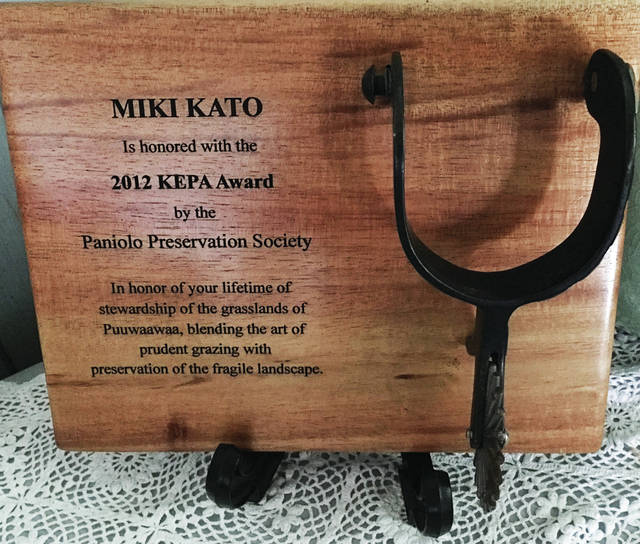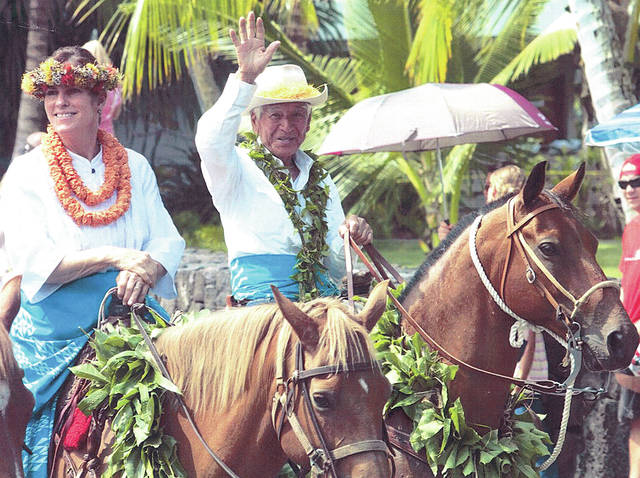Hanging up his cowboy hat: Veteran paniolo Miki Kato honored for 61 years on the ranch
HAWI — As a young man deciding what to do with his life, Mikio “Miki” Kato found his calling at home on the range — the wide open range of the Big Island’s 45,000-acre Puu Waawaa Ranch.
He hung up his cowboy hat for the last time in June at a retirement party in his honor after 61 years on the ranch. Kato was a respected cowboy, working on horseback for nearly 50 years, and spent the last decade monitoring the land by car as a consultant for the Department of Land and Natural Resources.
In July, he and his wife, Ellen, moved to Hawi.
Choosing to become a Hawaiian paniolo was an easy decision for Kato. Born on a combination ranch-dairy farm in Kealakekua, he was comfortable around animals. He also had experience working with livestock and liked riding horses.
His family’s property near Kona was a 3,000-acre parcel leased from Thomas A. Jaggar, the volcanologist for whom Volcano National Park Visitor’s Center is named. The land was on lower elevation and mostly lantana — “Rough places,” Kato recalled.
Because he didn’t like milking cows, his job, starting at age 6, was to round up cows early in the morning. Later in the day, he’d saddle up again to go looking for newborn calves. It was a lot of riding at an early age, but it made him comfortable in the saddle.
When he was 16, the family moved and he worked for the Greenwell and McCandless Ranches for 50 cents a day. That amount brings a laugh from Kato today. The work ranged from fixing fences to driving cattle.
“Wild cattle,” he remembered, “was a lotta action.”
Kato started working at the Puu Waawaa Ranch in 1956. After short stints working construction in Kona and serving in the National Guard, he welcomed the opportunity to be back on a horse.
On the ranch, “Nobody’s on your back eight hours a day. You’re out in the open,” Kato said.
He loved then, and still loves today, wide open spaces, and the rough rocky land of Puu Waawaa never phased him. His favorite spot was Hale Piula or “Iron Roofs,” named for the old water tanks that stood there.
“You could see over half the ranch from there, from the mountain down to the ocean,” Kato said.
Over the next five decades, he saw the ranch survive periods of drought, fire and intensive grazing regimes under three different owners. The last owner was Kato himself, who along with two others, acquired the ranch lease in 1997.
From the beginning, ranch managers saw something special in the diminutive Kato. He was soft spoken yet possessed a hard-as-nails, nose-to-the-ground work attitude. He never quit, just persevered. After just four months on the job, he was named maintenance supervisor, overseeing about 30 fencers, laborers and dozer operators.
In those early days on the ranch it was all about capital improvement. There was only one road and no water.
“We used to haul water from Waimea, day and night,” Kato remembered.
The ranch owner at the time, Lowell Dillingham, put in new roads, fences, pipeline and water catchment, both new and additional tanks. He even upgraded the cattle.
He told Kato, “These Herefords aren’t cutting it so I’m going to go to Texas and buy some bulls.”
“I thought he was kidding,” Kato said, but about two months later Dillingham told him, “Well, I bought 36 bulls in Texas and you’re going to go get them.”
That assignment resulted in one of Kato’s most challenging ranching experiences.
It was around 1965 or ’66 when he had to go all the way to Texas to get the bulls and truck them to San Francisco on three double-decker trucks. The first impediment came when the ship that was supposed to take the bulls to Hawaii got stuck outside the San Francisco harbor because of a gasoline barge burning in the middle of the bay.
“So here I come in to the wharf with three truckloads of bulls and I get stuck,” Kato remembered with a laugh. “I couldn’t send them back.”
He called Dillingham who in turn found a company that specialized in overseas shipping of big animals. Kato and his crew lined up the big crates right on the wharf with the bulls inside and waited — for three nights and four days.
After their ship arrived, another challenge presented itself. Because the bulls were wild, Kato and his crew couldn’t get near them. So to load them, they brought in a big forklift, hoisted the crates to deck level and then opened the gates to let the bulls go into the pen.
“We had a pen built on the ship, see?” Kato said.The next thing they had to do was unload the bulls upon their arrival on Oahu. The ship got in at about 8 p.m. and a big gang plank was unloaded to a truck waiting below.
“The truck was waiting but the lights were shining up so the bulls wouldn’t come out,” Kato said. “We had to play matador and tease the bulls until the bulls chased us and we ducked out on the side.”
The bulls came out four at a time, so 36 bulls took the workers until about 1:30 a.m. to unload.
Under the ranch’s next owner, F. Newell Bohnett, Kato became manager of ranch operations. During that time, workers upgraded all the corrals, roads and fences and also brought in new trucks and equipment. Kato advised Bohnett about a fresh water aquifer under the ranch and Bohnett subsequently decided to drill a fresh-water well.
“That was one the biggest improvements ever made on the ranch,” Kato said, because it meant fresh drinking water and no more water hauling and storage.
Threats to the ranch from drought and fire always loomed. Droughts were cyclic; once every 10 to 12 years you’d get a three-year continuous drought, Kato said, and there were fires every year. In response to such threats, he developed innovative solutions.
Working with a group of ranchers in the ’70s and ’80s, he completed a plan for fire fuel management using cattle to control the growth of grass, or understory, which feeds fire.
Kato was also ranch manager when Puu Waawaa was successfully opened for public hunting. The hunting program was started in response to much clamor by the public and plentiful wild game.
Poaching was heavy at the time so Kato suggested to the state Department of Fish and Wildlife that they open the ranch to the public. The DOFAW went with bird hunting first to assess how much damage the public would do to the ranch, which ended up being no damage at all.
“What we found out was, if you open it up to the public, the public has access and there are more eyes watching and less poaching and rustling, you know?” Kato said. “The public was glad they could come in so they’re weren’t going to destroy their chance of continuation.”
Hunter education classes were also started and as an added benefit, the hunters started helping the state plant native trees.
Throughout his years on the ranch, Kato became increasingly aware of the impact of range management practices on native and natural flora, fauna and forage. As he assumed a more active role in ranch management, he fostered grass management practices with an emphasis on rainfall, and on the rest and recovery of paddocks while using rotational grazing accordingly
Kato was named to the Paniolo Hall of Fame in 2002. He was also part of a group of paniolo honored when the 15th Annual Waimea Cherry Blossom Heritage Festival selected the Big Isle’s cowboys of Japanese heritage as their 2008 honorees.
As one of eight senior stewards of paniolo heritage, Kato was honored during the Paniolo Preservation Society’s (PPS) inaugural Lifetime Achievement Awards in January 2012 at the Paniolo Heritage Center at Pukalani Stables in Waimea. The awards program recognizes revered senior members of the Hawaii paniolo community whose careers exemplify the values of ranch life in the Far West. These individuals have distinguished themselves in performing their life’s work, which set them apart from others, commanding the respect of their peers.
“Hawaii’s uniquely insular ranching industry necessitates that knowledge and skill be passed on to the next generations if the heritage of paniolo life is to be perpetuated. A select group of individuals have carried out this unspoken responsibility,” said Paniolo Preservation Society Past President and Board Member Billy Bergin.
He continued, “The PPS applauds the lifetime efforts of Miki Kato in providing exemplary stewardship to the lands of Puu Waawaa while living in the spirit of aloha aina.”






